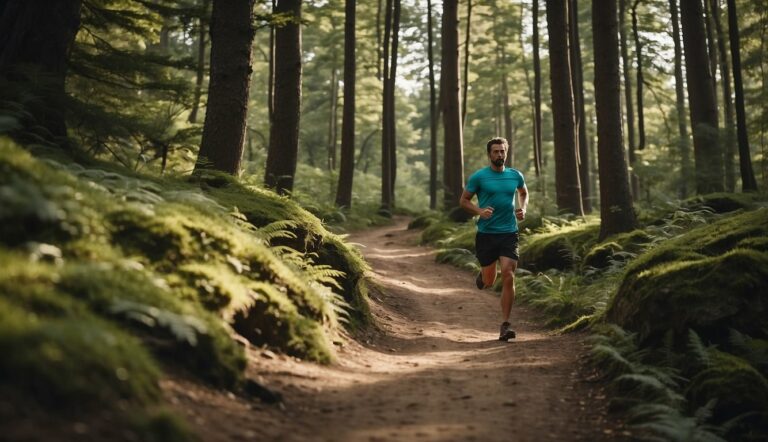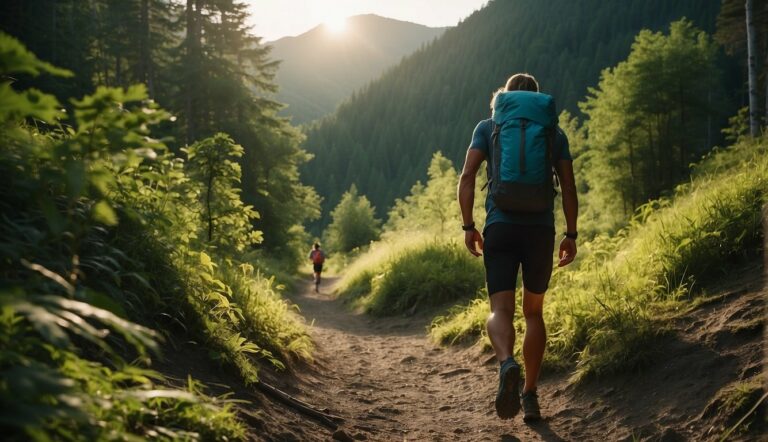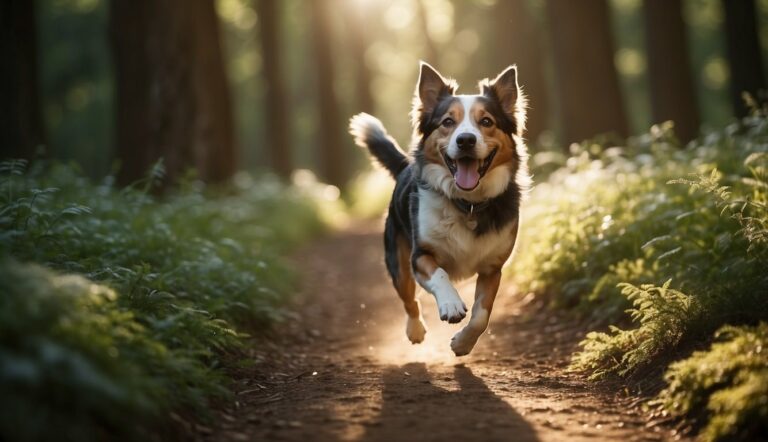The Art of Scrambling for Trail Runners: Steep and Technical Terrain Techniques
Scrambling is a dynamic and exhilarating way to explore steep mountainous terrain where hiking becomes climbing and the adventure intensifies. As an experienced UESCA certified running coach who has navigated numerous rock and ice-covered ascents, I’ve honed techniques that balance the physical challenge with safety. Whether it’s a rocky outcrop or a frozen waterfall, understanding the nuances of scrambling can turn an ordinary hike into an invigorating journey.
Navigating this transition from trail to climb requires a mix of agility and thoughtful decision-making. When I teach runners and adventurers about scrambling, I emphasize the importance of a deliberate approach to each step and handhold. Knowing when to employ basic techniques, such as the three points of contact rule, can be the difference between a successful scramble and an unnecessary risk.
My experiences ascending rugged landscapes have taught me that the right equipment and knowledge of the terrain are critical for a safe adventure. I always scout ahead, assessing for loose rock or precarious ice that could introduce hazards. It’s crucial to wear shoes that provide grip and stability, to check the weather to avoid sudden changes, and to have a clear understanding of one’s physical limits. Safety is paramount, as even a Class 3 scramble, with its need for handholds and potential for serious injury if one were to fall, demands respect and preparation.
Preparation and Safety

In scrambling, preparation and safety are as critical as the climb itself. I prioritize these to ensure a successful and secure adventure on steep terrain.
Understanding Scrambling Grades
Scrambling is classified into grades that indicate difficulty. Grade 1 is straightforward, requiring minimal use of hands. Grade 2 involves more handwork, and a mistake could be serious. Grade 3 is complex, where the use of a rope for protection is often recommended.
- Grade 1: Basic handholds, no technical gear needed
- Grade 2: Increased use of hands, may need a helmet
- Grade 3: Rope and climbing experience advised
Essential Gear and Equipment
Before scrambling, I check my equipment list for these essentials:
- Footwear: Durable hiking boots with a good grip
- Helmet: Protection from falling rocks
- Gloves: For handhold grip
- First Aid Kit: For emergencies
Having the right gear is non-negotiable for a safe scramble.
Weather Awareness and Hazard Management
I always assess weather conditions and hazards beforehand. Weather can change rapidly, increasing the risk of slips and falls. I stay informed through weather apps and by checking the forecast at the nearest ranger station. I avoid scrambling in wet conditions and start early to minimize risk.
- Weather: Check the forecast
- Hazards: Assess the trail condition
Navigation Skills and Route Finding
Good navigation is vital. I never head out without:
- Map: A detailed topographic map
- Guide: Sometimes I consult a guidebook or a local guide for route advice
- Compass: For direction
These tools help me plan my route and stay oriented on the trail.
**Note: This content provides general advice for scrambling preparation and safety. Always consult professional guides and local information sources for specific advice tailored to your climbing location.
Technical Skills Development
Mastering the art of scrambling requires not only physical strength but also the development of technical skills crucial for navigating steep and technical terrain with confidence.
Balance and Movement Fundamentals
My training starts with balance and movement. To build a solid base, I focus on exercises that enhance core stability and proprioception, which is the body’s ability to sense movement, action, and location. Engaging in activities like slacklining or practicing balance on uneven surfaces is beneficial.
Core Stability Exercises:
- Planks
- Russian twists
- Balance board routines
Proprioceptive Training:
- Barefoot exercises
- Stability ball workouts
- Yoga sequences
Advanced Footwork Techniques
Next, I hone in on footwork techniques. Precise placement of feet can make a big difference on tricky ascents. I often instruct scrambling enthusiasts to practice edging and smearing techniques on small rocks or climbing walls.
- Edging: Requires using the edge of hiking boots or shoes to gain grip on small ledges.
- Smearing: Entails pressing the sole of the boot or shoe flat against a surface for friction.
Handhold and Foothold Selection
Choosing the right handholds and footholds is crucial. I always assess the rock’s stability and my body’s position before committing to the next move. Selecting holds that allow for a balanced and controlled ascent is key, along with distributing weight evenly between hands and feet.
Stable Holds:
- Jug: a hold large enough to grip with the whole hand
- Edge: a hold with a lip that fingers can grasp
Weight Distribution:
- 60/40 Rule: Aim to keep approximately 60% of weight on the feet and 40% on the hands to avoid fatigue.
Rope Skills for Scrambling
While scrambling often doesn’t involve ropes, certain Class 4 terrains recommend a rope for safety. Basic rope skills, such as tying secure knots and managing rope tension, are essential for those more technical scrambles.
Essential Knots:
- Figure-eight: a strong and easy-to-inspect knot
- Bowline: creates a secure loop at the end of a rope
Rope Management:
- Avoiding tangles
- Ensuring proper tension to aid movement without slack.
Terrain Considerations

When approaching steep and technical terrain for scrambling, understanding the surface and conditions is crucial for safety and success. Here are key considerations for different types of terrain.
Scrambling on Rock Surfaces
Rocky terrain often consists of steep inclines that demand careful foot placement and handholds. Ensure your hiking boots provide sufficient grip and always test rock stability before committing weight. Here’s a quick reference:
- Type of Rock: Check if it’s sedimentary, igneous, or metamorphic. Sedimentary rocks tend to be less stable.
- Surface Condition: Look for dry, solid surfaces. Avoid mossy or wet rocks which can be slippery.
Navigating Snow and Ice Terrain
When you encounter snow and ice, use tools like ice axes and crampons for better traction and stability. Remember to adjust your technique for the hardness of the ice:
- Soft Snow: A simple kick step might be enough for good footing.
- Hard Ice: Swing your ice axe and carefully place your crampons for a secure grip.
Dealing with Exposed Sections
Exposed sections of the trail can present significant risk due to high exposure and potential for falls. Keep a steady pace, focus on secure hand/foot placements, and stay calm. If you’re uncomfortable, consider using a rope for added security.
- Exposure Level: Assess the drop-offs on either side of the path and plan your moves accordingly.
- Mental Preparedness: Stay composed, and don’t rush through exposed areas.
Managing Steep and Rough Terrain
The most challenging aspects often involve navigating through steep, uneven, or loose rough terrain. Here’s what to consider:
- Steepness: Use techniques like the duck walk or side stepping for steep slopes.
- Terrain Stability: Anticipate loose gravel or dirt and move with care to avoid slipping.
By paying attention to the details specific to rock, ice, exposure, and surface, you can improve your scrambling experience significantly. Remember, the right technique and a thorough assessment of the terrain can enhance both enjoyment and safety.
Physical Conditioning and Training

To excel in scrambling terrains, I focus on a regimen that emphasizes strength, endurance, flexibility, and balance. Let’s explore how to enhance these physical attributes specifically for the demands of scrambling.
Improving Overall Fitness
For scrambling, I find that a strong baseline of fitness is crucial. This includes cardiovascular health, which can be developed through activities like running, cycling, or swimming. I often incorporate interval training to improve my heart’s ability to cope with varied intensity levels that mimic a scramble’s ebb and flow of exertion.
- Cardiovascular Activities:
- Running: 3-5 times a week, varying distance and pace
- Cycling: 30-60 minutes, moderate to high intensity
- Swimming: 20-30 laps, focusing on breath control
Strength Training for Scramblers
Upper and lower body strength are both vital. For my upper body, I perform exercises like pull-ups and push-ups to improve my ability to lift and hold my body weight. For my lower body, squats and lunges build the power needed to push up steep inclines.
- Upper Body Exercises:
- Pull-ups: 3 sets of 5-10 repetitions
- Push-ups: 3 sets of 10-20 repetitions
- Lower Body Exercises:
- Squats: 3 sets of 10-15 repetitions
- Lunges: 3 sets of 10 repetitions per leg
Endurance and Speed Training
Endurance training includes longer, less intense workouts, essential for long scrambles. To improve speed, which can be necessary for quick ascents, I practice short bursts of activity like sprints or hill repeats.
- Endurance Workouts:
- Long-distance runs: 1-2 times a week, 60+ minutes
- Hiking: incorporating weighted packs for added resistance
- Speed Workouts:
- Sprints: 8-12 x 100 meters, full recovery between sets
- Hill repeats: 5-10 uphill bursts of 30-60 seconds
Agility and Lower Body Coordination
Training for agility helps me safely navigate rocky and uneven surfaces. I use ladder drills and balance exercises to improve coordination. Targeting the leg muscles through plyometric exercises like box jumps also enhances my ability to maneuver unexpected terrain changes.
- Agility Drills:
- Ladder drills: Forward, lateral, and backpedal sequences
- Balance exercises: Single-leg stands, Bosu ball exercises
- Plyometric Exercises:
- Box jumps: 3 sets of 8-10 repetitions
- Jump squats: 3 sets of 10-12 repetitions
Mental Strategies
Scrambling requires not only physical agility but also mental toughness. Here, I’ll share firsthand knowledge on how to sharpen your mental game for dealing with steep and technical terrain.
Maintaining Focus During Scrambles
Maintaining focus is essential for the safety and success of your scramble. Develop a mental routine to stay present:
- Plan your route in advance, but be adaptable.
- Break the route into manageable sections and concentrate on one at a time.
- Breathing techniques can help keep your mind centered.
Risk Assessment and Decision Making
Risk assessment is about making informed decisions:
- Evaluate terrain constantly: Look for changes in rock stability or steepness.
- Assess conditions: Weather can change rapidly, affecting the risk.
- Use a risk-benefit analysis to make sound decisions—know when to proceed and when to turn back for safety.
Handling Fear and Adrenaline
Managing adrenaline and fear is crucial for scrambling:
- Acknowledge your fear as a sound signal for caution, but don’t let it overwhelm you.
- Convert adrenaline into positive energy for focus and strength.
- Build confidence with each scramble, using past experiences as a guide for future challenges.
In my experience, a well-prepared mind is as vital as a fit body when tackling the spontaneity and challenge of the wild terrain. Stay composed, assess risks continually, and manage your emotions to maintain confidence throughout your adventure.





